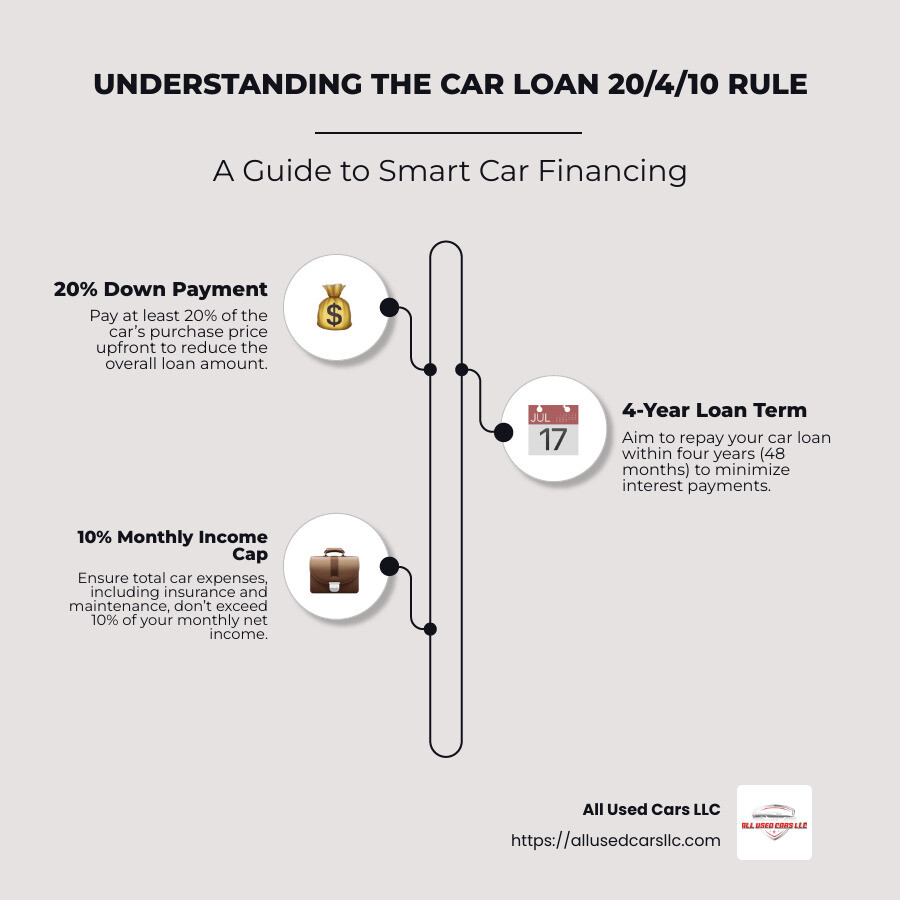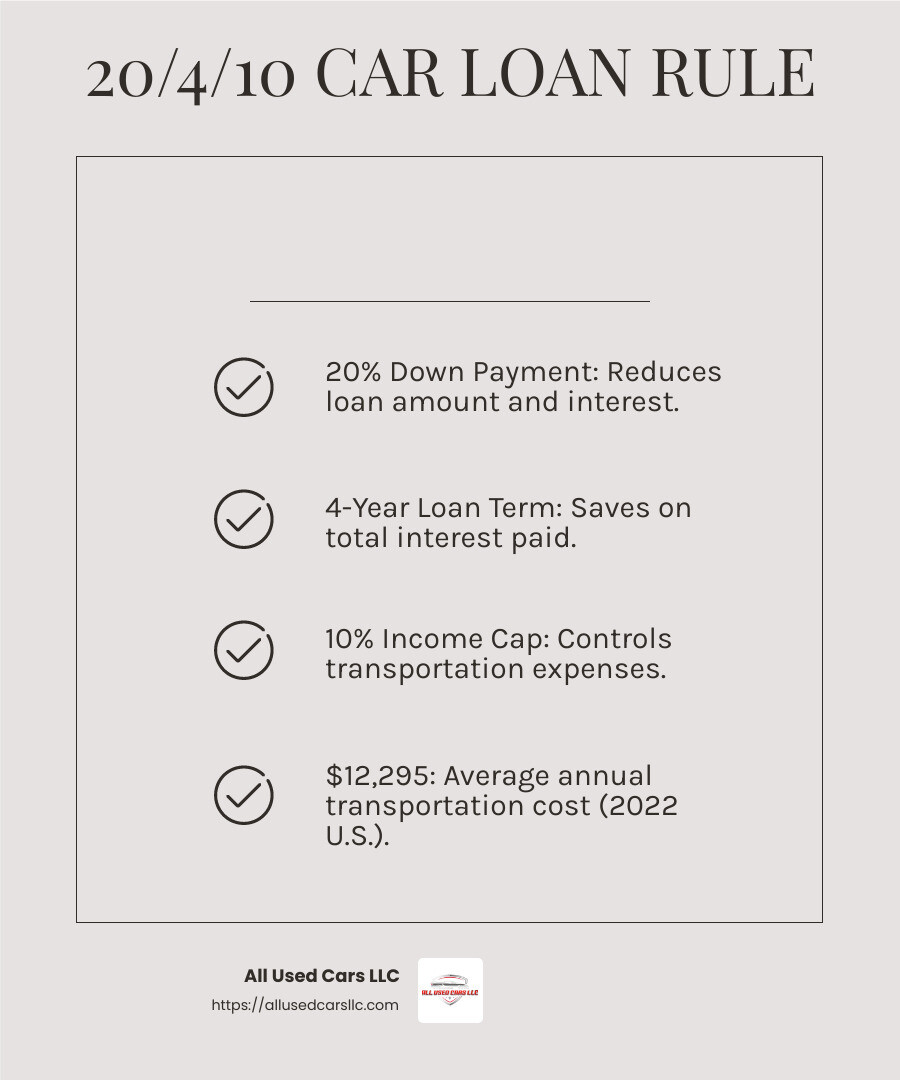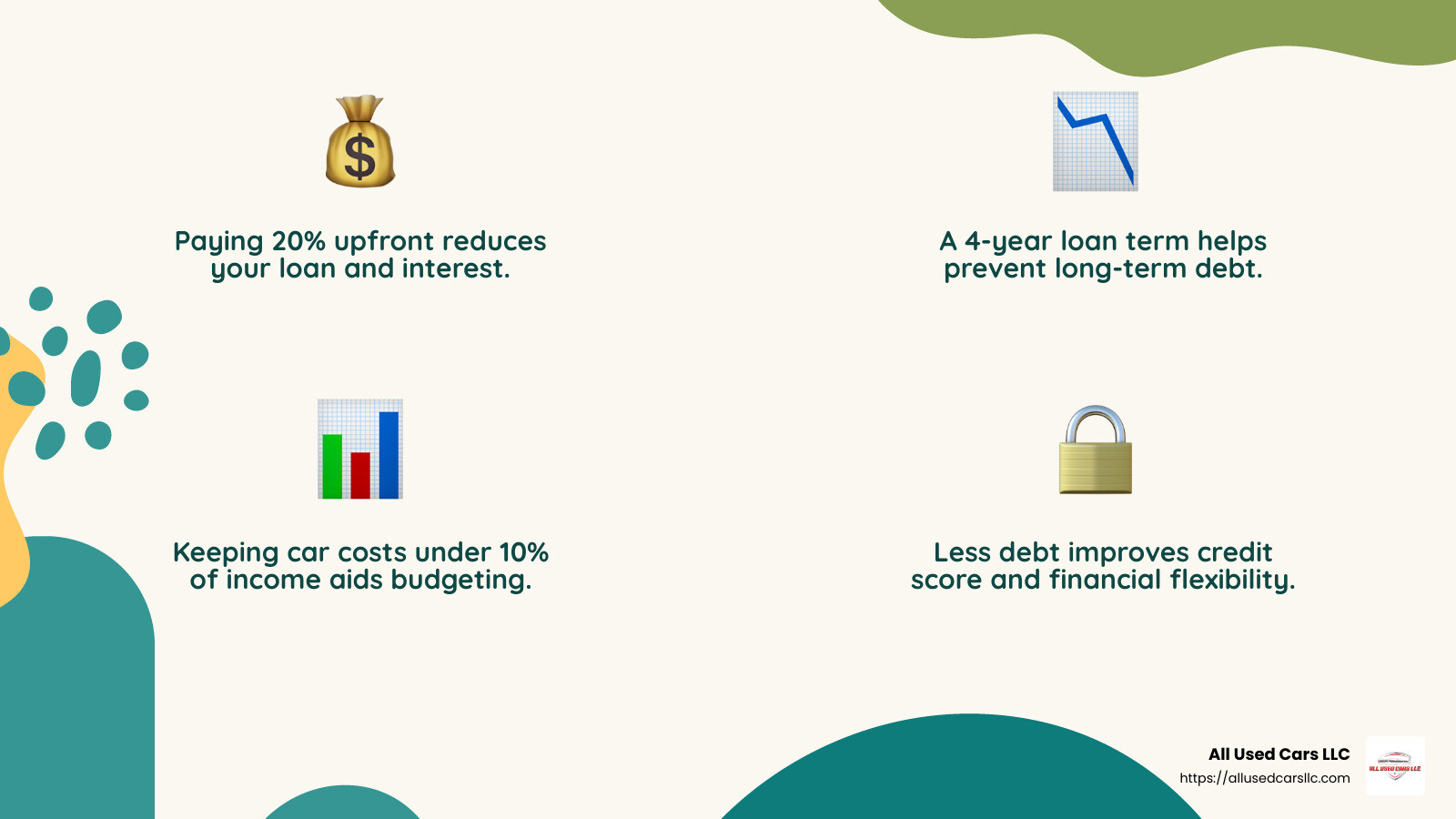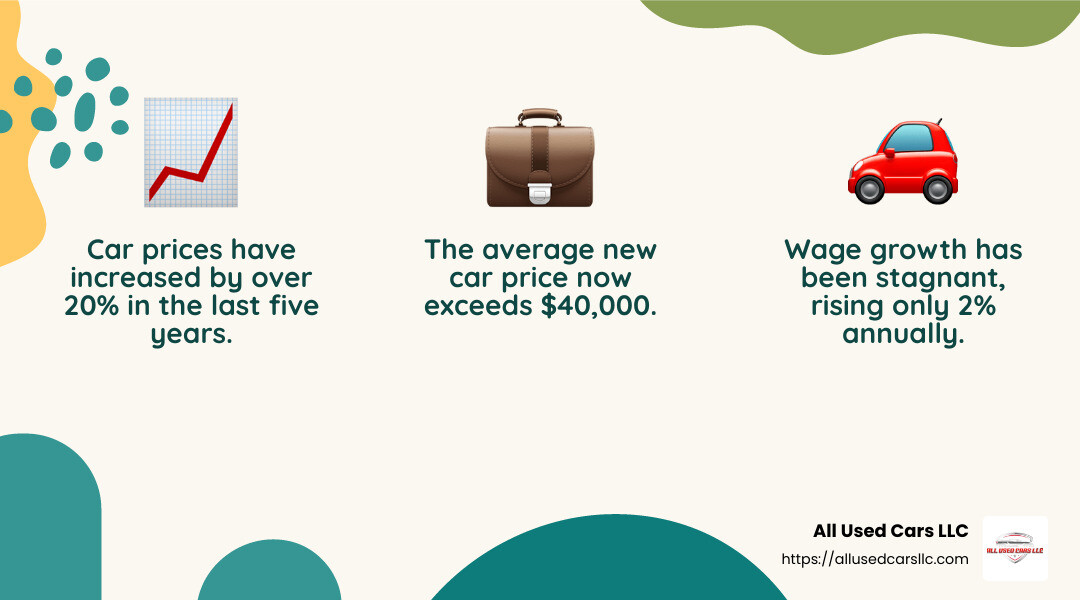
Car Loan 20 4 10: Top Rule for Smart Budgeting 2024
Are you looking to buy a car without leaving a dent in your budget? The car loan 20 4 10 guideline is a simple yet effective strategy to help you steer the complex world of car financing.
For those who prefer a quick summary, here’s what you need to know:
- 20% Down Payment: Pay at least 20% of the car’s purchase price upfront.
- 4-Year Loan Term: Aim to repay your car loan within four years (48 months).
- 10% Monthly Income Cap: Ensure total car expenses, including insurance and maintenance, don’t exceed 10% of your monthly net income.
Buying a car is a significant financial commitment, and planning your budget is crucial. With the 20/4/10 rule, you not only keep your dreams of owning a car within reach, but you also ensure long-term financial health. This guideline considers down payments, loan terms, and monthly income limitations to help you make informed decisions that suit your lifestyle and financial situation.
Navigating the used car market can be daunting, but with clear financial guidelines, you can find a car that fits your needs and your wallet. Whether you’re eyeing a sleek sedan or a sturdy SUV, let’s explore how you can use this approach to make your car buying journey a smooth and successful one.
Car loan 20 4 10 helpful reading:
Understanding the 20/4/10 Rule
When buying a car, it’s easy to get overwhelmed by the numbers and options. The 20/4/10 rule offers a simple framework to guide you through this process.
Let’s break it down:
20% Down Payment
Start by setting aside 20% of the car’s price as a down payment. This upfront payment reduces the amount you need to borrow, which in turn lowers your monthly payments and the total interest paid over time.
Why 20%?
A substantial down payment can prevent you from being “upside-down” on your loan. This means you won’t owe more on the car than it’s worth. Plus, lenders often offer better interest rates to those who make significant down payments, viewing them as less risky borrowers.
4-Year Loan Term
Next, aim for a loan term of no more than four years. While longer loans might seem attractive due to lower monthly payments, they often result in paying more interest over time.
Here’s a quick example:
- Shorter Loan (4 years): Higher monthly payments, less total interest.
- Longer Loan (6+ years): Lower monthly payments, more total interest.
By sticking to a four-year term, you ensure that you pay off your car faster and save on interest.
10% Monthly Income Cap
Finally, keep your car-related expenses under 10% of your monthly income. This includes not just your loan payment, but also insurance, fuel, and maintenance.
This cap helps maintain balance in your budget, ensuring you have enough left over for other expenses and savings goals. According to data from the Department of Transportation, U.S. households spent an average of $12,295 on transportation in 2022. Using the 10% rule can help manage these costs effectively.
In summary, the 20/4/10 rule is a practical tool to ensure you don’t overspend on a car. By focusing on a significant down payment, a manageable loan term, and keeping expenses in check, you can enjoy your new ride without financial stress.
Next, we’ll explore the benefits of following this rule and how it can lead to a more stable financial future.
Benefits of the 20/4/10 Rule
The 20/4/10 rule isn’t just a set of numbers—it’s your ticket to smarter car buying. Let’s explore how this rule helps with affordability, financial stability, and budgeting.
Affordability
At its core, the 20/4/10 rule is about making car ownership affordable. By paying 20% upfront, you reduce the amount you need to borrow. This means smaller loan payments and less interest over time. Plus, you’re less likely to owe more than the car is worth, which can happen if the car depreciates faster than you pay off the loan.
By following this rule, you ensure that your car expenses don’t eat up too much of your budget. Keeping all car-related costs under 10% of your monthly income allows you to enjoy your vehicle without sacrificing other life expenses.
Financial Stability
This rule is a blueprint for financial stability. A shorter loan term of four years means you pay off your car faster, freeing up your finances for other goals. This approach helps prevent long-term debt and the stress that comes with it.
Why is this important?
According to financial experts, carrying less debt improves your credit score and gives you more financial flexibility. It’s like having a safety net for unexpected expenses or opportunities.
Budgeting
The 20/4/10 rule simplifies budgeting. With clear guidelines on down payments, loan terms, and monthly expenses, you can plan your finances with confidence. This structure helps you allocate funds efficiently, ensuring you meet other financial goals like saving for emergencies or investing for the future.
By sticking to this rule, you create a balanced financial plan that accommodates both your current needs and future aspirations.
In summary, the 20/4/10 rule is about more than just buying a car. It’s about making smart financial choices that lead to a stable and stress-free financial future. Up next, we’ll look at how to apply this rule with practical examples and calculations.
How to Apply the 20/4/10 Rule
Applying the 20/4/10 rule can make car buying less daunting and more manageable.
Let’s break it down into three simple steps: down payment calculation, loan term selection, and monthly income allocation.
1. Down Payment Calculation
Start by calculating how much you can put down on the car. The rule suggests a 20% down payment.
Here’s how you can figure it out:
- Check your savings: Look at how much you have set aside for this purchase.
- Trade-in value: If you have a car to trade in, use tools like Kelley Blue Book to estimate its value.
- Subtract existing loans: If you owe money on your current car, subtract this amount from its trade-in value.
Add your savings and the trade-in value, then multiply by 5 to figure out the maximum total price of the car you can afford.
Example: If you have $3,000 in savings and a trade-in worth $2,000, your down payment calculation would be:
($3,000 + $2,000) x 5 = $25,000
Your car budget should be $25,000 or less.
2. Loan Term Selection
The next step is choosing a loan term. The 20/4/10 rule recommends a 4-year loan term (48 months) or less. Here’s why:
- Shorter loans mean less interest paid over time.
- You’ll own the car outright sooner, freeing up your budget for other expenses.
When you’re at the dealership or bank, ask for a loan that fits this term. A shorter loan also helps avoid the risk of being “upside down” on your loan, where you owe more than the car is worth.
3. Monthly Income Allocation
Finally, manage your monthly budget by ensuring all car-related expenses stay within 10% of your monthly income.
This includes:
- Loan payments
- Insurance
- Fuel
- Maintenance
Example: If your monthly take-home pay is $4,000, your total car expenses should be:
$4,000 / 10 = $400
This means your car loan payment, insurance, gas, and maintenance should not exceed $400 per month.
By following these steps, you can apply the 20/4/10 rule effectively, ensuring your car purchase is a smart financial decision. Next, we’ll explore a practical example to see this rule in action.
Car Loan 20 4 10: A Practical Example
Let’s see how the 20/4/10 rule works in a real-world scenario. This example helps illustrate how you can use this guideline to make informed decisions on loan calculations, interest rates, and monthly payments.
Loan Calculation
Imagine you’re looking to buy a car with a total price of $20,000. Here’s how you would apply the rule:
- Down Payment: Start with a 20% down payment.
- For a $20,000 car, that’s:
[20\% \times 20,000 = 4,000]
You would need to pay $4,000 upfront.
- Remaining Amount: After the down payment, the remaining balance you need to finance is: [20,000 – 4,000 = 16,000]
Interest Rates and Loan Term
With the 20/4/10 rule, you aim for a loan term of 4 years (48 months). Suppose you secure an interest rate of 5%. Now, let’s calculate the monthly payment using this interest rate and term.
- Monthly Payment Formula: Use an auto loan calculator or the formula for monthly payments:
[M = \frac{P \times r \times (1 + r)^n}{(1 + r)^n – 1}]
Where:
- ( M ) is the monthly payment.
- ( P ) is the principal loan amount ($16,000).
- ( r ) is the monthly interest rate (annual rate divided by 12 months, i.e., 5%/12).
- ( n ) is the number of payments (48 months).
- Calculate Monthly Payment: Plug in the numbers to find your monthly payment. For simplicity, let’s say it comes out to around $368 per month.
Monthly Payments and Budget
Finally, ensure your total car expenses stay within 10% of your monthly income. If your monthly income is $4,000:
- Maximum Transportation Costs:
[4,000 / 10 = 400]
Your total car expenses, including the $368 loan payment, insurance, fuel, and maintenance, should not exceed $400.
By following this example, you can see how the car loan 20 4 10 rule keeps your car purchase within a manageable budget. It ensures you don’t overspend and allows room for other financial commitments. Next, let’s tackle some frequently asked questions about this rule.
Frequently Asked Questions about the 20/4/10 Rule
What is the 20/4/10 rule for car loans?
The 20/4/10 rule is a simple guideline to help you decide if a car purchase fits within your budget.
Here’s how it breaks down:
- 20% Down Payment: You should aim to pay at least 20% of the car’s purchase price upfront. This minimizes the loan amount and helps avoid being upside down on your loan.
- 4-Year Loan Term: Keep the loan term to four years or less. This reduces the interest paid over time and ensures you pay off the car quickly.
- 10% of Monthly Income: Your total car-related expenses (including the loan payment, insurance, fuel, and maintenance) should not exceed 10% of your monthly income. This keeps your car expenses manageable and leaves room for other financial needs.
How does the 20/4/10 rule compare to other car financing rules?
The 20/4/10 rule is not the only method people use to determine car affordability.
Here are a couple of other popular rules:
- 20/3/8 Rule: This is a stricter version of the 20/4/10 rule. It suggests a 20% down payment, a 3-year loan term, and total car expenses under 8% of your monthly income. Critics argue it’s too restrictive, especially in today’s market.
- 50/30/20 Rule: This broader budgeting rule suggests allocating 50% of your income to needs, 30% to wants, and 20% to savings and debt repayment. While not specific to car buying, it can guide overall financial planning, including car expenses.
Each rule has its pros and cons, and the best choice depends on your financial situation and priorities.
Is the 20/4/10 rule still relevant today?
The 20/4/10 rule remains a helpful guideline, but it’s important to consider current economic conditions. Inflation and rising car prices can make sticking to this rule challenging. For instance, the average price of a new car has increased significantly over the years, outpacing wage growth.
Despite these challenges, the 20/4/10 rule still provides a solid framework for assessing car affordability. It encourages thoughtful budgeting and helps prevent overspending. However, it’s crucial to adapt the rule to your financial circumstances and the current market environment.
Conclusion
At All Used Cars LLC, we understand that buying a car is a significant financial decision, and it’s crucial to find a balance between your needs and your budget. The 20/4/10 rule offers a practical framework to guide your decision-making process, ensuring that your car purchase remains affordable and doesn’t strain your finances.
Car affordability is more than just the sticker price. It’s about considering all associated costs, including insurance, maintenance, and fuel, and ensuring these fit comfortably within your budget. By adhering to the 20/4/10 rule, you can make a more informed decision, avoiding the pitfalls of overextending yourself financially.
In today’s economic climate, where factors like inflation and rising car prices can complicate financial planning, having a clear guideline is invaluable. The 20/4/10 rule helps you stay grounded, encouraging you to make responsible choices that align with your financial goals.
At All Used Cars LLC, we are committed to supporting you on this journey. With our extensive network across the USA, we offer a wide selection of quality used vehicles that fit various budgets and preferences. Whether you’re in California, Texas, or anywhere else from our list of locations, we are here to help you find the right car at a competitive price.
Explore our used cars for sale and take the first step towards a financially sound car purchase. Let us assist you in applying the 20/4/10 rule to make your next car purchase both affordable and satisfying.




